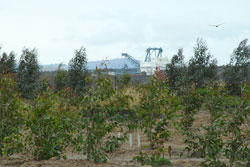
Recycled organics key to mine site revegetation

Planting trees on former mine sites is easier said than done, according to NSW Department of Primary Industries forestry scientist, Dr Georgina Kelly.
Although the community expects mining companies to revegetate old mine sites, and they are legally required to carry out rehabilitation works, there is little Australian data on how best to establish trees in the soil overburden.
Dr Kelly says the mining process exposes thousands of tonnes of nutrient-poor, waste rock, subsoils and process wastes that first need stabilising.
“Most mines are short of topsoil and the overburden often lacks nutrients and organic matter”.
Dr Kelly is currently undertaken a scientific trial of the use of different types of recycled organic material on establishment, survival and growth of eucalypts on a mine site near Ravensworth, in the upper Hunter Valley.
The trial is funded by the NSW Department of Environment and Conservation (DEC) and is an initiative of the Sustainability Programmes Division.
Materials being trialled include recycled organics (composted mulch and soil conditioner processed from recycled garden materials), municipal waste compost and biosolids.
“It is common practice to use mineral fertilisers to improve soil quality, but adding more fertiliser does not improve the microbiological activity in the soil, which is necessary for a sustainable system.
“Adding recycled organics or biosolids will improve microbiological activity and will provide nutrients to the plants over a longer period.”
To test the impact of different types of organic and fertiliser inputs, a plantation of two different eucalypt species has been established – and treated with eight different soil amendments.
She said that after 24 months, trees in plots treated with either biosolids alone, or biosolids combined with mulch, grew higher and had a greater stem diameter.
However there was a greater survival rate and more consistent growth when soil conditioner (made from 100% composted garden material) and municipal waste compost were applied.
Dr Kelly said a critical factor in the Hunter Valley is soil moisture – and mulch proved the most effective treatment in maintaining soil moisture.
“Initial data indicates that recycled organics can have a significant role in increasing tree growth and survival and improving soil moisture loss, making them a valuable resource for mine site rehabilitation”, she said.
A comprehensive review of the use of recycled organics on mine sites by Dr Kelly was recently published on the DEC website. Called ‘Recycled Organics in Mine Site Rehabilitation - A review of scientific literature’ (June 2006), it is available from the EPA website. It's current address is http://www.epa.nsw.gov.au/resources/warrlocal/060184-mine-lit-review.pdf
Email:

